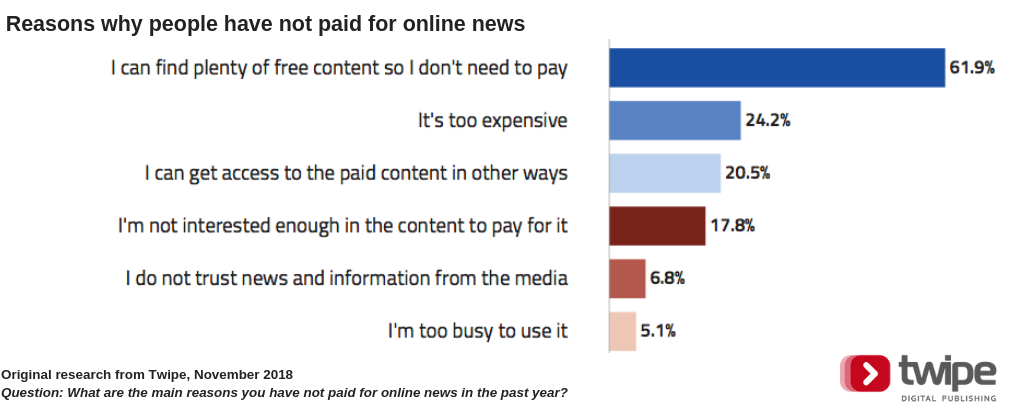Insights on reader willingness to pay for online news
The funding crisis in journalism has dominated the industry conversations in recent years, whether it be about paywall strategies, diversifying revenues, or generating direct reader revenues.
With this in mind, we started our latest research in the “Reinventing Digital Editions” series, in which we surveyed 4,000 news consumers across Europe and the United States. Our findings were recently released in the report “Reinventing Digital Editions: Reader Insights“, which includes reader personas developed through one-on-one interviews with 30 readers.
In this article we dive into the findings on reader willingness to pay for online news, make sure to download the full report for more research on other news reader behaviours, format preference, and news consumption trends.
Abundance of free content stops readers from paying
By far, the most common reason readers give for why they do not pay for digital news is because they can find plenty of free content already elsewhere (61.9% of respondents). We can clearly see that the abundance of free content online is the biggest blocker in successfully capturing digital reader revenues for many newspapers today.
From this we see further evidence of Rachel Davis Mersey’s prediction for news in 2019: local news becomes truly local.
The evidence that audiences are unwilling to pay for local news is actually clouded by the fact that most local news is not local at all.
Rachel Davis Mersey, assistant professor at the Medill School of Journalism, Media, Integrated Marketing Communications at Northwestern University
With the internet, anything other than truly local news competes against a deluge of free content from various sources, further lowering reader willingness to pay for digital news.

The cost of paying for digital news and the ability to access the paid content in different ways (such as coming from social or by-passing the paywall using incognito mode) are also common reasons for not paying. A distrust in media accounts only for 6.8% of respondents globally — however this number spikes to 17.5% in the US and 12.5% in the UK.
Readers willing to pay for specific online news formats
In a surprising finding, 30.6% of respondents who pay for digital news said they started paying because they could not get the specific format for free elsewhere. Savvy publishers will take note of this finding to innovate on their format strategies for premium content in 2019.

What stands out as well is how only 11.7% of respondents cite hitting a paywall as the trigger for them to subscribe. While this might seem to be an anomaly, in fact we can read it as further proof that many publishers still need to refine their paywall strategies. One of the most crucial aspects of a paywall strategy is ensuring readers actually do see the paywall at some point. We expect to see tighter and tighter paywalls from publishers in 2019, following the example of The New York Times, which first launched a paywall with 20 stories per month for free and then subsequently halved this amount twice to finally land on 5 stories.
Paywalls aren’t just important for acquisition, but also for retention
Getting a reader to start paying for online news is only half the battle. We know how important retention (and engagement) strategies are — after all, industry-wide half of all new subscribers will churn in the first three months.
The most common reason respondents give for why they do continue to pay for online news is the unlimited access to digital news stories. We can see that a paywall is indeed important in your retention strategy.

In our interviews with readers, we also found respondents appreciate the guarantee of digital always being ready for them early in the morning, as sometimes the print newspaper would arrive too late for their morning routine. Other respondents listed the ability to stay up to date with their local news anywhere they go as the main reason they stay subscribed. One respondent explained that as he often travels, his digital subscription allows him to ‘keep the newspaper habit through digital.’ This aspect of habit-formation is key, and is indeed a particular concern for our research going forward.
For more on reader willingness to pay for online news, make sure to download the full report. We also recommend the following articles and podcasts on other findings from our research report:
- Global Editors Network: Daily Editions vs. Continuous Newsflow — How do users prefer news today?
- Journalism.co.uk: What makes readers pay for online news?
- The Business of Content: A new study sheds light on what drives paid subscriptions for news
This article was written by Mary-Katharine Phillips, Media Innovation Analyst at Twipe from 2017 – 2021.
Other Blog Posts

Stay on top of the game
Join our community of industry leaders. Get insights, best practices, case studies, and access to our events.
"(Required)" indicates required fields

